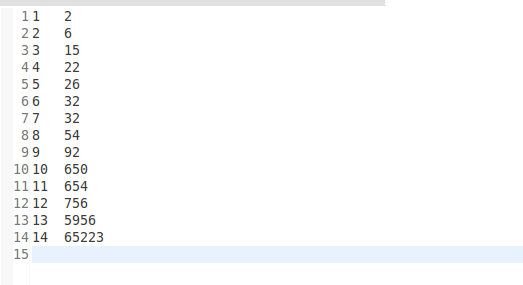数据排序是许多实际任务在执行时要完成的第一项工作,比如学生成绩评比、数据建立索引等。这个实例和数据去重类似,都是先对原始数据进行初步处理,为进一步的数据操作打好基础。
1.实例描述
对输入文件中的数据进行排序。输入文件中的每行内容均为一个数字,即一个数据。要求在输出中每行有两个间隔的数字,其中,第二个数字代表原始数据,第一个数字这个原始数据在原始数据集中的位次。
样例输入:
file1:
2
32
654
32
15
756
65223
file2:
5956
22
650
92
file3:
26
54
6
样例输出:

2.设计思路
这个实例仅仅要求对输入数据进行排序,熟悉MapReduce过程的读者很快会想到在MapReduce过程中就有排序。是否可以利用这个默认的排序、而不需要自己在实现具体的排序呢?答案是肯定的。但是在使用之前首先要了解MapReduce过程中的默认排序规则。它是按照key值进行排序,如果key为封装int的IntWritable类型,那么MapReduce按照数字大小对key排序;如果key为封装String的Text类型,那么MapReduce按照字典顺序对字符串排序。需要注意的是,Reduce自动排序的数据仅仅是发送到自己所在节点的数据,使用默认的排序并不能保证全局的顺序,因为在排序前还有一个partition的过程,默认无法保证分割后各个Reduce上的数据整体是有序的。所以要想使用默认的排序过程,还必须定义自己的Partition类,保证执行Partition过程之后所有Reduce上的数据在整体上是有序的,然后再对局部Reduce上的数据进行默认排序,这样才能保证所有数据有序。了解了这个细节,我们就知道,首先应该使用封装int的IntWritable型数据结构,也就是将读入的数据在Map中转化为IntWritable型,然后作为key值输出(value任意);其次需要重写partition,保证整体有序,具体做法是用输入数据的最大值除以系统partition数量的商作为分割数据的边界增量,也就是说分割数据的边界为此商的1倍、2倍至numPartitions-1倍,这样就能保证执行partition后的数据是整体有序的;然后Reduce获得<key,value-list>之后,根据value-list中元素的个数将输入的key作为value的输出次数,输出的key是一个全局变量,用于统计当前key的位次。需要注意的是,这个程序中没有配置Combiner,也就是说在MapReduce过程中不使用Combiner。这主要是因为使用Map和Reduce就已经能够完成任务了。
3.程序代码:
程序代码如下:
1 import java.io.IOException; 2 3 import org.apache.hadoop.conf.Configuration; 4 import org.apache.hadoop.fs.Path; 5 import org.apache.hadoop.io.IntWritable; 6 import org.apache.hadoop.io.Text; 7 import org.apache.hadoop.mapreduce.Job; 8 import org.apache.hadoop.mapreduce.Mapper; 9 import org.apache.hadoop.mapreduce.Partitioner; 10 import org.apache.hadoop.mapreduce.Reducer; 11 import org.apache.hadoop.mapreduce.lib.input.FileInputFormat; 12 import org.apache.hadoop.mapreduce.lib.output.FileOutputFormat; 13 import org.apache.hadoop.util.GenericOptionsParser; 14 15 16 17 public class Sort { 18 19 // map将输入中的value转化成IntWritable类型,作为输出的key 20 public static class Map extends Mapper<Object, Text, IntWritable, IntWritable>{ 21 private static IntWritable data = new IntWritable(); 22 @Override 23 protected void map(Object key, Text value,Mapper<Object, Text, IntWritable, IntWritable>.Context context) 24 throws IOException, InterruptedException { 25 // super.map(key, value, context); 26 String line = value.toString(); 27 data.set(Integer.parseInt(line)); 28 context.write(data, new IntWritable(1)); 29 } 30 } 31 // reduce 将输入的key复制到输出的value上,然后根据输入的 value-list 中元素的个数决定key的输出次数 32 // 用全局linenum来代表key的位次 33 public static class Reduce extends Reducer<IntWritable, IntWritable, IntWritable, IntWritable>{ 34 private static IntWritable linenum = new IntWritable(1); 35 @Override 36 protected void reduce(IntWritable key, Iterable<IntWritable> values,Reducer<IntWritable, IntWritable, IntWritable, IntWritable>.Context context) 37 throws IOException, InterruptedException { 38 // super.reduce(arg0, arg1, arg2); 39 for(IntWritable val : values){ 40 context.write(linenum, key); 41 linenum = new IntWritable(linenum.get()+1); 42 } 43 } 44 } 45 // 自定义Partition函数,此函数根据输入数据的最大值和 MapReduce 框架中 Partition 的数量获取将输入数据按照大小分块的边界, 46 //然后根据输入数值和边界的关系返回对应的 Partition ID 47 public static class Partition extends Partitioner<IntWritable, IntWritable>{ 48 @Override 49 public int getPartition(IntWritable key, IntWritable value, int numPartitions) { 50 int Maxnumber = 65223; 51 int bound = Maxnumber/numPartitions + 1; 52 int keynumber = key.get(); 53 for (int i = 0; i < numPartitions; i++) { 54 if (keynumber < bound * (i+1) && keynumber >= bound *i) { 55 return i; 56 } 57 } 58 return -1; 59 } 60 } 61 public static void main(String[] args) throws IOException, ClassNotFoundException, InterruptedException { 62 Configuration conf = new Configuration(); 63 String[] otherArgs = new GenericOptionsParser(conf,args).getRemainingArgs(); 64 if(otherArgs.length!=2){ 65 System.out.println("Usage:Score Avg"); 66 System.exit(2); 67 } 68 Job job = new Job(conf,"Sort"); 69 job.setJarByClass(Sort.class); 70 job.setMapperClass(Map.class); 71 job.setPartitionerClass(Partition.class); 72 job.setReducerClass(Reduce.class); 73 job.setOutputKeyClass(IntWritable.class); 74 job.setOutputValueClass(IntWritable.class); 75 76 FileInputFormat.addInputPath(job, new Path(args[0])); 77 FileOutputFormat.setOutputPath(job, new Path(args[1])); 78 79 System.exit(job.waitForCompletion(true)?0:1); 80 } 81 82 }